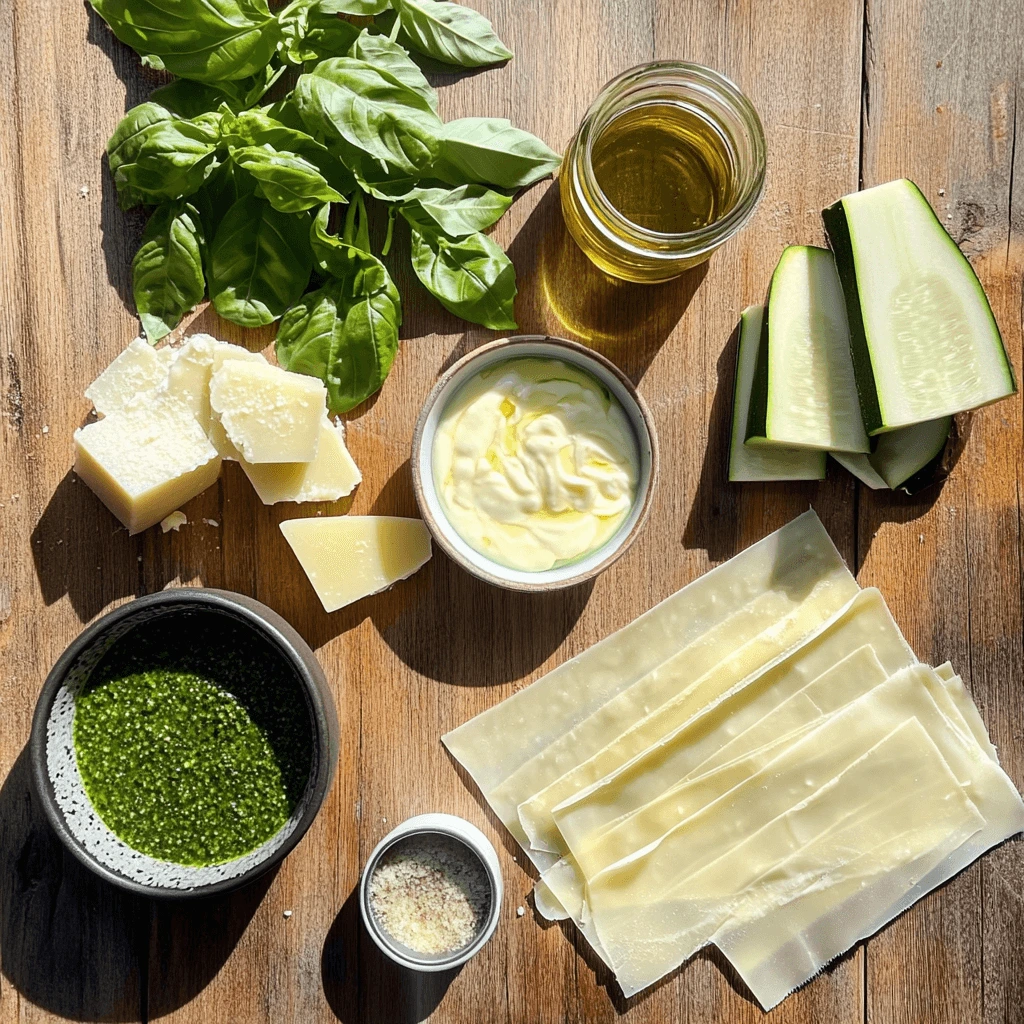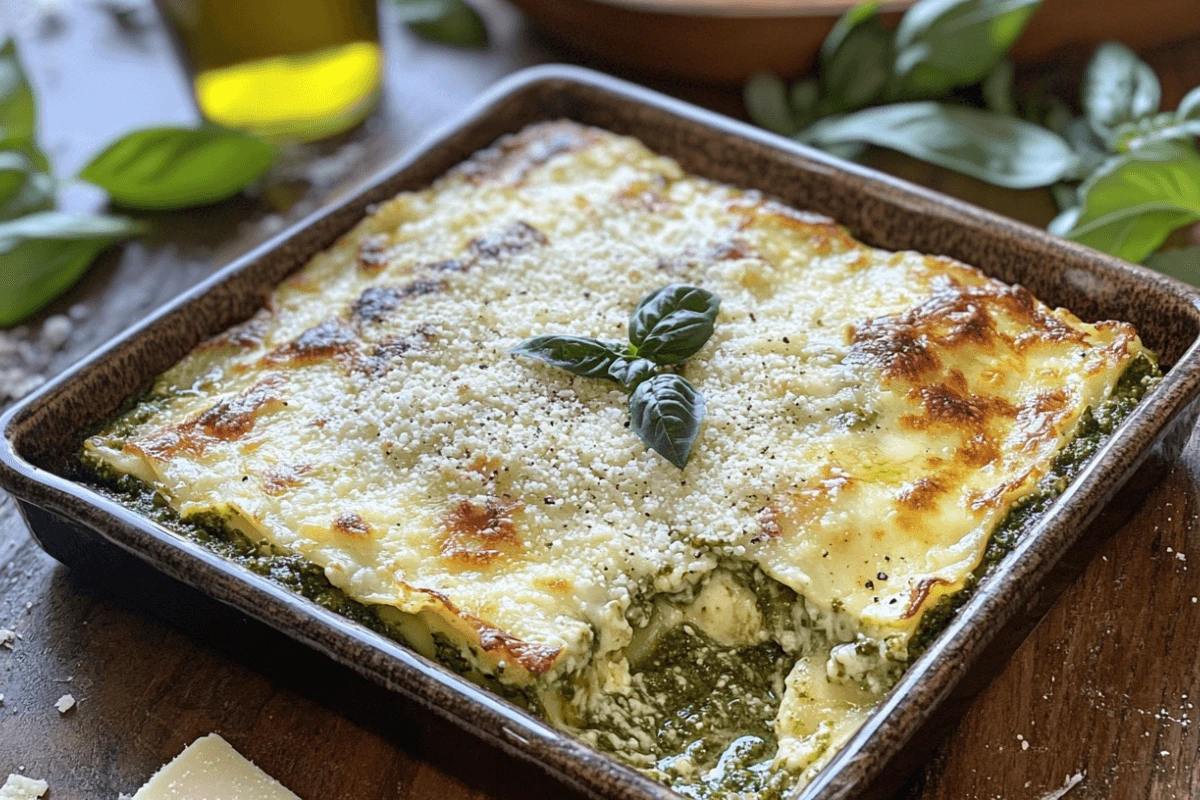Introduction to Ligurian Lasagna
Overview of Ligurian Cuisine
When you think of Italian food, your mind probably jumps to pizza and spaghetti, right? But Ligurian lasagna, a hidden gem of Ligurian cuisine, deserves the spotlight.
Liguria is a stunning coastal region in northwest Italy, known for its Mediterranean flavors, fresh produce, and seafood. Think of fragrant herbs like basil, bright citrus, and ingredients straight from the sea. It’s no wonder this area is famous for its pesto—a vibrant green sauce made with fresh basil, pine nuts, Parmesan, garlic, and olive oil.
What makes Ligurian dishes special is their simplicity. The recipes rely on fresh, high-quality ingredients to create bold, satisfying flavors without overcomplicating things. This philosophy carries over to Ligurian lasagna, a dish that’s as comforting as it is unique.
What Is Ligurian Lasagna?
Ligurian lasagna is not your typical layered pasta dish. Forget the heavy meat sauces and mozzarella overload; this version is all about fresh, bright flavors. Instead of a tomato-based sauce, Ligurian lasagna features layers of creamy béchamel and fragrant pesto. Between the sauces, you’ll find sheets of tender pasta, sautéed vegetables like zucchini or spinach, and just the right amount of cheese.
What really sets it apart? The pesto. It’s the heart and soul of this dish, adding a punch of flavor that’s impossible to resist. This lasagna is lighter than the traditional version, making it perfect for warm-weather meals or when you’re craving something cozy but not overly rich. It’s a recipe that brings a little taste of Liguria to your table—without booking a flight to Italy.
Now that you know what makes Ligurian lasagna so special, let’s dive into the ingredients and prep work. Don’t worry—it’s easier than it sounds, and I’ve got some handy tips to make it a breeze!
Table of contents
Ingredients and Preparation
Key Ingredients in Ligurian Lasagna
To make Ligurian lasagna, you’ll need a handful of fresh ingredients that come together to create something truly magical. Don’t worry—nothing here is overly fancy or hard to find. Let’s break it down:

1. Pasta Types
Fresh pasta is a game-changer for this recipe. Traditionally, Ligurian lasagna uses thin sheets of homemade pasta made with just flour and eggs. If you’ve got the time and energy to roll it out yourself, go for it! (It’s easier than you think, and the flavor is unbeatable.) But store-bought lasagna sheets work just fine too. If you’re using dried pasta, be sure to boil it until it’s al dente before layering. For a gluten-free option, look for gluten-free lasagna noodles or try zucchini slices as a low-carb alternative.
2. Sauces
The sauces are the heart of this dish:
- Pesto Sauce: The vibrant green pesto brings Ligurian lasagna to life. Blend fresh basil, pine nuts, Parmesan, garlic, and olive oil until smooth. Store-bought pesto works too, but homemade is unbeatable.
- Béchamel Sauce: This creamy white sauce adds richness and balances the bold flavors of the pesto. It’s made with butter, flour, and milk, whisked together until silky smooth. Add a pinch of nutmeg for a classic touch.
These two sauces create layers of flavor you won’t forget!
3. Vegetables
Ligurian lasagna leans on fresh, seasonal veggies for extra texture and flavor. Zucchini, spinach, and even artichokes are common choices. Lightly sauté them with olive oil, garlic, and a pinch of salt to enhance their natural sweetness.
4. Cheeses
While Ligurian lasagna doesn’t go overboard on cheese, a few types are key:
- Ricotta: Adds creaminess and blends beautifully with the béchamel.
- Parmesan: Sprinkled between layers for that nutty, salty goodness.
- Mozzarella: Optional, but a little melted mozzarella never hurt anyone, right?
Step-by-Step Preparation Guide
Now, let’s get to the fun part—assembling this masterpiece!
1. Making the Pasta from Scratch
If you’re going the homemade route, combine 2 cups of flour and 3 eggs in a bowl. Knead the dough for about 10 minutes until it’s smooth and elastic, then let it rest for 30 minutes. Roll it out thinly using a rolling pin or pasta maker, and cut it into sheets that fit your baking dish.
2. Preparing the Sauces
- Pesto Sauce: Blend 2 cups of fresh basil, 1/4 cup pine nuts, 1/2 cup grated Parmesan, 2 cloves of garlic, and 1/2 cup olive oil until smooth. Add salt to taste.
- Béchamel Sauce: Melt 2 tablespoons of butter in a saucepan. Whisk in 2 tablespoons of flour and cook for 1-2 minutes. Slowly add 2 cups of milk, whisking constantly until the sauce thickens. Season with salt, pepper, and a pinch of nutmeg.
3. Layering the Lasagna
- Start with a thin layer of béchamel sauce at the bottom of your baking dish to prevent sticking.
- Add a layer of pasta sheets, followed by a spread of pesto, a drizzle of béchamel, and a sprinkle of Parmesan.
- Add sautéed vegetables on top for some texture and flavor.
- Repeat the layers until you’ve used up your ingredients, finishing with a final layer of béchamel and a sprinkle of Parmesan.
Pro Tip: Let the lasagna sit for 15-20 minutes before baking to help the layers settle.
Cooking Techniques and Tips
Cooking Ligurian lasagna might seem like a simple “pop it in the oven” task, but a few techniques can make all the difference. Let’s talk about how to achieve lasagna perfection—crispy edges, creamy layers, and all!
1. Boiling vs. Baking: The Pasta Debate
If you’re using fresh pasta, there’s no need to pre-boil it. The sauces provide enough moisture to cook the pasta perfectly as it bakes. However, if you’re using dried pasta sheets, it’s a good idea to boil them for 2-3 minutes until they’re just pliable (but not fully cooked). This prevents them from soaking up too much liquid during baking, which can lead to a dry lasagna.
For gluten-free pasta, check the package instructions. Most brands recommend pre-cooking to avoid uneven textures.
2. Baking Time and Temperature
Preheat your oven to 375°F (190°C) for the best results. Cover your lasagna with foil for the first 25-30 minutes of baking to prevent it from drying out. This traps steam, helping the pasta cook evenly.
After 30 minutes, remove the foil to let the top layer get that golden, bubbly finish. Bake for another 15-20 minutes, keeping an eye on it to avoid over-browning. If you want those crispy edges, broil the lasagna for 2-3 minutes at the end—but don’t walk away!
3. Resting Time Before Serving
Here’s a secret that makes all the difference: Let the lasagna rest for at least 15-20 minutes after baking. This allows the layers to set, making it easier to slice and serve without everything sliding apart. Plus, the flavors meld together during this time, giving you a more cohesive and delicious dish.
Common Mistakes to Avoid
Even the best cooks can run into hiccups. Here are a few pitfalls to watch out for:
1. Overcooking the Pasta
Overcooked pasta is a lasagna killer. Boil it for just a couple of minutes (if at all) to keep it firm enough to hold up to layering and baking. If you overdo it, the pasta can become mushy and fall apart during cooking.
2. Skipping Resting Time
I get it—you’re hungry, and the lasagna smells amazing. But skipping the resting time can ruin all your hard work. Without this step, the layers will slide apart, and you’ll end up with a messy plate instead of perfect slices.
3. Using Too Much Sauce
It’s tempting to go heavy-handed with pesto and béchamel, but too much sauce can overwhelm the pasta and veggies. Stick to thin, even layers. This ensures the flavors balance beautifully and the dish isn’t overly rich or soggy.
4. Forgetting the Seasoning
Don’t forget to season each component. While pesto and Parmesan are naturally flavorful, your béchamel and veggies need a pinch of salt and pepper to shine. Lightly season as you go—it’s the difference between a good lasagna and a great one!
With these tips, your Ligurian lasagna will be cooked to perfection. Next up, let’s talk about how to serve it and explore some creative variations to make this dish your own!
Discover the delicious Galena Chicken Recipe and try a comforting bowl of White Turkey Chili for your next meal.
Serving Suggestions and Variations
Traditional Serving Suggestions
Ligurian lasagna is already a star on its own, but pairing it with the right sides and beverages can take your meal to the next level. Here are some classic and easy ideas to round out your menu:
1. Fresh, Simple Salads
A crisp salad balances the richness of the lasagna. Try a basic arugula and Parmesan salad with a drizzle of olive oil and lemon juice. Or toss together mixed greens, cherry tomatoes, and cucumbers with a light vinaigrette. The bright, tangy flavors cut through the creamy sauces beautifully.
2. Crusty Bread
No Italian meal is complete without bread! Serve warm, crusty bread or garlic knots for soaking up all that béchamel and pesto goodness. Trust me, it’s the ultimate comfort food combo.
3. Wine Pairings
Ligurian lasagna pairs wonderfully with a crisp white wine like Vermentino or a light red like Pinot Noir. Prefer non-alcoholic options? A sparkling water with lemon or iced herbal tea works just as well.
Variations of Ligurian Lasagna
Want to switch things up? Ligurian lasagna is versatile enough for plenty of creative spins. Whether you’re feeding vegetarians or seafood lovers, these ideas will keep things fresh:
1. Vegetarian Options
Ligurian lasagna is already veggie-forward, but you can customize it further:
- Add roasted eggplant or bell peppers for extra layers of flavor.
- Swap ricotta for a vegan alternative and use plant-based milk in the béchamel for a dairy-free version.
- Experiment with different greens like Swiss chard or kale for a nutrient-packed twist.
2. Seafood Variations
As a coastal region, Liguria loves its seafood, and incorporating it into lasagna is a no-brainer.
- Add cooked shrimp, crab meat, or chunks of white fish like cod between the layers.
- Replace béchamel with a light cream sauce infused with garlic and lemon for a coastal flair.
- Top with breadcrumbs mixed with parsley and olive oil for a crunchy, seafood-friendly finish.
3. Gluten-Free and Low-Carb Alternatives
For a gluten-free option, use gluten-free pasta sheets or layer zucchini slices in place of pasta. Want to keep it low-carb? Skip the pasta altogether and focus on layering veggies, pesto, and béchamel for a lighter, yet equally satisfying dish.
Add variety to your menu with the classic Galena Chicken Recipe and a nutritious Tomato Florentine Soup option.
FAQ: All About Lasagna – From Luxury Versions to Regional Traditions
1. What is the world’s most expensive lasagna?
The world’s most expensive lasagna is made by Chef Renato Viola in his luxury dining experience, costing around $100 per portion. This over-the-top lasagna includes premium ingredients like Kobe beef, black truffle shavings, and buffalo mozzarella sourced from Italy. It’s typically served as part of an exclusive, gourmet multi-course meal designed for food enthusiasts who want to indulge in the ultimate lasagna experience.
2. What city in Italy is known for lasagna?
The city of Bologna, located in the Emilia-Romagna region of Italy, is best known for lasagna. Bologna is home to the classic Lasagna alla Bolognese, which features layers of green spinach pasta, a hearty meat-based ragù, béchamel sauce, and Parmesan cheese. This iconic dish reflects the region’s rich culinary heritage and is considered one of the finest examples of traditional Italian cuisine.
3. What is the difference between northern Italian lasagna and southern Italian lasagna?
The key difference lies in the ingredients and preparation:
- Northern Italian Lasagna: Typically features a béchamel sauce and a meat-based ragù (like Bolognese). It’s known for its creamy, delicate flavors and often includes spinach pasta.
- Southern Italian Lasagna: Often incorporates a tomato-based sauce, mozzarella cheese, and sometimes ricotta. Southern versions are heartier, with bold flavors, and may include additions like sausage, meatballs, or boiled eggs, which are common in Naples.
Each style reflects the regional preferences and available ingredients, showcasing the diversity of Italian cuisine.
4. Why do Italians put hard-boiled eggs in lasagna?
In southern Italy, especially in Naples, hard-boiled eggs are a traditional addition to lasagna. This practice dates back to times when lasagna was a celebratory dish made for holidays or special occasions. The eggs add a rich, hearty texture and symbolize abundance. Alongside ingredients like ricotta, sausage, or meatballs, the eggs make the lasagna more filling and reflect the festive nature of the dish.
Conclusion: Bringing Ligurian Lasagna to Your Table
Congratulations—you’re now equipped with everything you need to create a stunning Ligurian lasagna! From its unique pesto and béchamel layers to the fresh vegetables and perfectly tender pasta, this dish brings a taste of coastal Italy right to your kitchen. Whether you’re cooking for family, hosting friends, or simply treating yourself, Ligurian lasagna is a recipe that’s sure to impress.
Remember, the beauty of this dish lies in its versatility. You can stick to the traditional recipe or explore variations with seafood, vegetarian twists, or gluten-free options. Pair it with a fresh salad, crusty bread, and maybe a glass of wine, and you’ve got a meal that’s as elegant as it is comforting.
So, what are you waiting for? Grab those ingredients, roll up your sleeves, and get cooking! Once you’ve perfected your layers and baked it to golden-bubbly perfection, don’t forget to share your masterpiece—because, let’s face it, lasagna this good deserves a spot on your Instagram feed. Plus, when your friends see it, they’ll be asking for a dinner invite in no time. Buon appetito, and happy cooking!


1 thought on “Ligurian Lasagna Recipe: Fresh Pesto and Béchamel Layers”